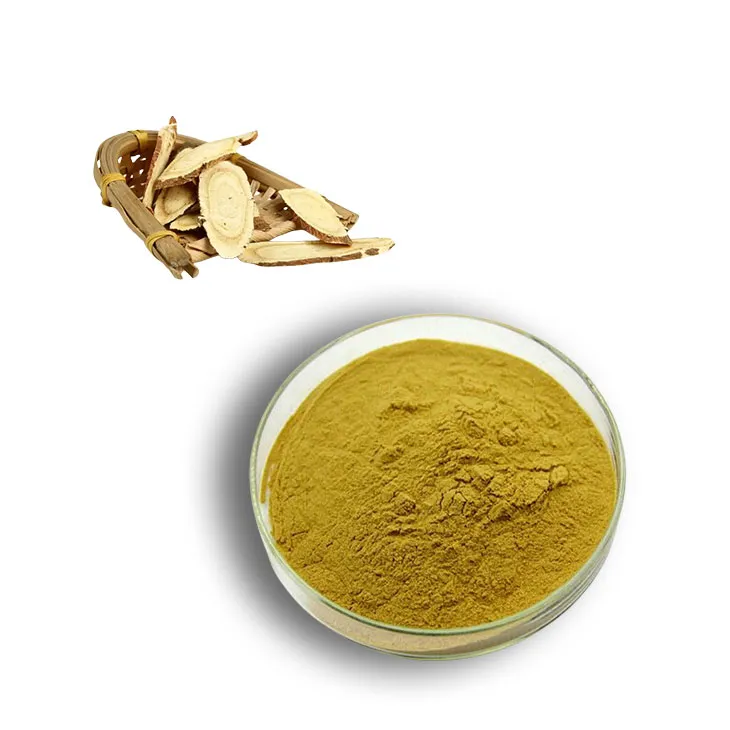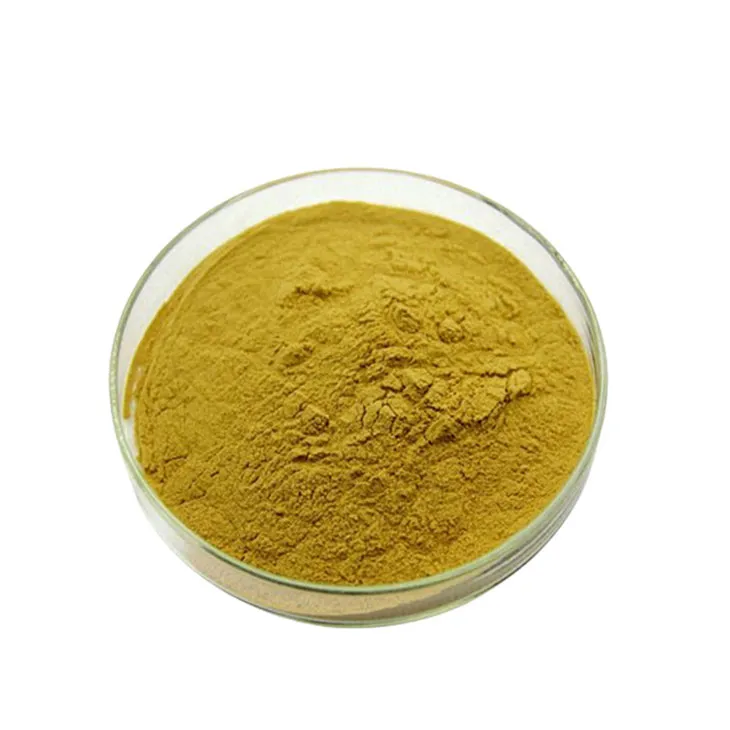- 0086-571-85302990
- sales@greenskybio.com
The process of extracting glycyrrhizic acid from licorice root extract powder.
2024-11-28

1. Introduction
Licorice root has been used for centuries in traditional medicine due to its various pharmacological properties. One of the most important components in licorice root is glycyrrhizic acid. The extraction of glycyrrhizic acid from Licorice Root Extract Powder is of great significance as it has potential applications in the pharmaceutical, food, and cosmetic industries.

2. Properties of licorice root relevant to glycyrrhizic acid extraction
Licorice root contains a rich amount of glycyrrhizic acid, along with other components such as flavonoids and polysaccharides. The chemical structure of glycyrrhizic acid makes it soluble in certain solvents, which is a key factor in the extraction process. Licorice root also has a porous structure that can influence the mass transfer during extraction.

3. Extraction methods
3.1 Solvent extraction
Solvent extraction is one of the most commonly used methods for glycyrrhizic acid extraction from Licorice Root Extract Powder.
- The first step is to select an appropriate solvent. Ethanol, methanol, and water are often considered. Ethanol, for example, has a relatively good solubility for glycyrrhizic acid and is also relatively safe and easy to handle.
- Next, the Licorice Root Extract Powder is mixed with the solvent at a certain ratio. This ratio can affect the extraction efficiency. For instance, a ratio of 1:10 (licorice root extract powder to solvent) may be initially tested.
- The mixture is then stirred or shaken for a certain period. This agitation helps to increase the contact between the powder and the solvent, facilitating the dissolution of glycyrrhizic acid. A typical agitation time could be 2 - 4 hours.
- After that, the mixture is filtered to separate the solid residue from the liquid extract containing glycyrrhizic acid. Filtration can be carried out using filter paper or a filtration device.
- Finally, the solvent can be evaporated to obtain the glycyrrhizic acid. However, care must be taken during evaporation to avoid over - heating, which may damage the glycyrrhizic acid.
3.2 Supercritical fluid extraction
Supercritical fluid extraction is a more advanced extraction method.
- Supercritical carbon dioxide (scCO₂) is often used as the supercritical fluid. It has properties such as low toxicity, high diffusivity, and easy separation from the extract.
- The licorice root extract powder is placed in an extraction vessel. The temperature and pressure are adjusted to bring the carbon dioxide to its supercritical state. For example, a temperature of around 40 - 60 °C and a pressure of 10 - 30 MPa may be used.
- The supercritical carbon dioxide then penetrates the licorice root extract powder and selectively extracts glycyrrhizic acid.
- By changing the pressure and temperature conditions, the solubility of glycyrrhizic acid in the supercritical fluid can be controlled, allowing for better separation and purification.
- After extraction, the supercritical fluid is depressurized, and the glycyrrhizic acid is collected.

4. Optimization of extraction methods
Optimizing the extraction process is crucial to improve the yield and purity of glycyrrhizic acid.
- For solvent extraction, the choice of solvent and its concentration can be optimized. Different solvents may have different affinities for glycyrrhizic acid and other impurities. By carefully selecting and adjusting the solvent, a higher yield and purity can be achieved. For example, a mixture of ethanol and water in a certain proportion may be more effective than using a single solvent.
- The extraction time and temperature also play important roles. Longer extraction times may increase the yield, but it may also lead to the extraction of more impurities. Similarly, higher temperatures can enhance the solubility, but may cause degradation of glycyrrhizic acid. Therefore, a balance needs to be found through experimental optimization.
- In the case of supercritical fluid extraction, the optimization of pressure, temperature, and flow rate of the supercritical fluid is essential. These parameters can significantly affect the extraction efficiency and selectivity. For instance, a higher flow rate may increase the mass transfer rate, but it may also reduce the residence time of the supercritical fluid in the extraction vessel, affecting the extraction yield.
- Pretreatment of licorice root extract powder can also improve the extraction. For example, grinding the powder to a finer size can increase the surface area, facilitating better contact with the solvent or supercritical fluid during extraction.

5. Purification of glycyrrhizic acid
After extraction, the obtained glycyrrhizic acid may still contain impurities.
- One common purification method is chromatography. Column chromatography, for example, can be used. A suitable stationary phase and mobile phase are selected based on the chemical properties of glycyrrhizic acid and the impurities. For glycyrrhizic acid, a silica - based stationary phase and a solvent - based mobile phase may be used.
- Crystallization is another method. By adjusting the temperature and concentration, glycyrrhizic acid can be crystallized out, leaving the impurities in the solution. This requires careful control of the crystallization conditions to obtain high - purity glycyrrhizic acid.
6. Potential applications of glycyrrhizic acid
Glycyrrhizic acid has a wide range of potential applications.
- In the pharmaceutical industry, it has anti - inflammatory, antiviral, and anti - ulcer properties. It can be used in the development of drugs for treating various diseases such as hepatitis, peptic ulcers, and respiratory infections.
- In the food industry, it can be used as a natural sweetener. Glycyrrhizic acid is much sweeter than sucrose, and it also has a unique flavor. It can be added to some foods and beverages as a flavor enhancer and sweetener.
- In the cosmetic industry, glycyrrhizic acid has antioxidant and skin - whitening properties. It can be used in skin care products such as creams, lotions, and serums to improve skin health and appearance.
7. Conclusion
The extraction of glycyrrhizic acid from licorice root extract powder is a complex process involving multiple steps and factors. By choosing appropriate extraction methods, optimizing the extraction process, and purifying the obtained glycyrrhizic acid, high - quality glycyrrhizic acid can be obtained. The potential applications of glycyrrhizic acid in various industries make this extraction process highly valuable. Future research may focus on further improving the extraction efficiency, reducing costs, and exploring more potential applications.
FAQ:
What are the main properties of licorice root that are relevant to glycyrrhizic acid extraction?
Licorice root contains glycyrrhizic acid in a relatively high concentration. It also has a complex chemical composition with other compounds that can be separated from glycyrrhizic acid during the extraction process. The root has a certain structure that can be disrupted to release the glycyrrhizic acid, such as cell walls that can be broken down to access the acid. Moreover, the solubility characteristics of glycyrrhizic acid within the licorice root matrix play an important role in determining the feasibility of different extraction methods.
Can you briefly introduce solvent extraction for glycyrrhizic acid?
Solvent extraction is a commonly used method. In this process, a suitable solvent is selected based on the solubility of glycyrrhizic acid. For example, polar solvents are often considered as glycyrrhizic acid has polar characteristics. The licorice root extract powder is mixed with the solvent, and through processes like agitation and soaking, the glycyrrhizic acid is dissolved into the solvent. Then, separation techniques such as filtration or centrifugation are used to separate the extract containing glycyrrhizic acid from the solid residue. Finally, further purification steps may be required to obtain high - purity glycyrrhizic acid.
What are the advantages of supercritical fluid extraction in glycyrrhizic acid extraction?
Supercritical fluid extraction has several advantages. Firstly, it can operate at relatively mild conditions compared to some traditional extraction methods, which helps to preserve the integrity of glycyrrhizic acid. Secondly, supercritical fluids have good diffusivity and solubility, which can lead to a high extraction efficiency. Thirdly, the selectivity of supercritical fluid extraction can be adjusted by changing parameters such as pressure and temperature, allowing for better separation of glycyrrhizic acid from other components in the licorice root extract powder. Additionally, it is often considered a more environmentally friendly method as it can reduce the use of harmful solvents.
How can the yield of glycyrrhizic acid be improved during the extraction process?
To improve the yield, optimizing the extraction parameters is crucial. For solvent extraction, this may include adjusting the solvent type, concentration, extraction time, and temperature. For supercritical fluid extraction, parameters like pressure, temperature, and flow rate need to be optimized. Also, pretreatment of the licorice root extract powder, such as grinding to a finer particle size to increase the surface area, can enhance the extraction yield. Another approach is to use multiple extraction cycles or combine different extraction methods to ensure more complete extraction of glycyrrhizic acid.
What are the potential applications of the extracted glycyrrhizic acid?
The extracted glycyrrhizic acid has various potential applications. In the pharmaceutical industry, it has anti - inflammatory, antiviral, and antioxidant properties, so it can be used in the development of drugs for treating certain diseases. In the food industry, it can be used as a natural sweetener and flavor enhancer. Additionally, in the cosmetic industry, it is used in products for its skin - soothing and anti - aging properties.
Related literature
- Extraction and Purification of Glycyrrhizic Acid from Licorice: A Review"
- "Optimization of Glycyrrhizic Acid Extraction from Licorice Root by Different Methods"
- "The Properties and Applications of Glycyrrhizic Acid Derived from Licorice Root Extract"
- ▶ Hesperidin
- ▶ citrus bioflavonoids
- ▶ plant extract
- ▶ lycopene
- ▶ Diosmin
- ▶ Grape seed extract
- ▶ Sea buckthorn Juice Powder
- ▶ Beetroot powder
- ▶ Hops Extract
- ▶ Artichoke Extract
- ▶ Reishi mushroom extract
- ▶ Astaxanthin
- ▶ Green Tea Extract
- ▶ Curcumin Extract
- ▶ Horse Chestnut Extract
- ▶ Other Problems
- ▶ Boswellia Serrata Extract
- ▶ Resveratrol Extract
- ▶ Marigold Extract
- ▶ Grape Leaf Extract
- ▶ blog3
- ▶ blog4
-
The best lemon juice powder in nature.
2024-11-28
-
Organic Vitamin K2 Powder Suppliers
2024-11-28
-
Bulk purchase of L - tyrosine.
2024-11-28
-
Vitamin K2 Manufacturers
2024-11-28
-
100% Pure Natural Rutin.
2024-11-28
-
Chinese Citrus Bioflavonoid Suppliers.
2024-11-28
-
Camu Camu Extract
2024-11-28
-
Hops Extract
2024-11-28
-
Epimedium extract powder
2024-11-28
-
Panax Ginseng Leaf Extract
2024-11-28
-
Plantain extract
2024-11-28
-
Konjac Powder
2024-11-28
-
Pomegranate Extract
2024-11-28
-
Clove Powder
2024-11-28
-
White Willow Bark Extract
2024-11-28
-
Passionflower Extract
2024-11-28





















